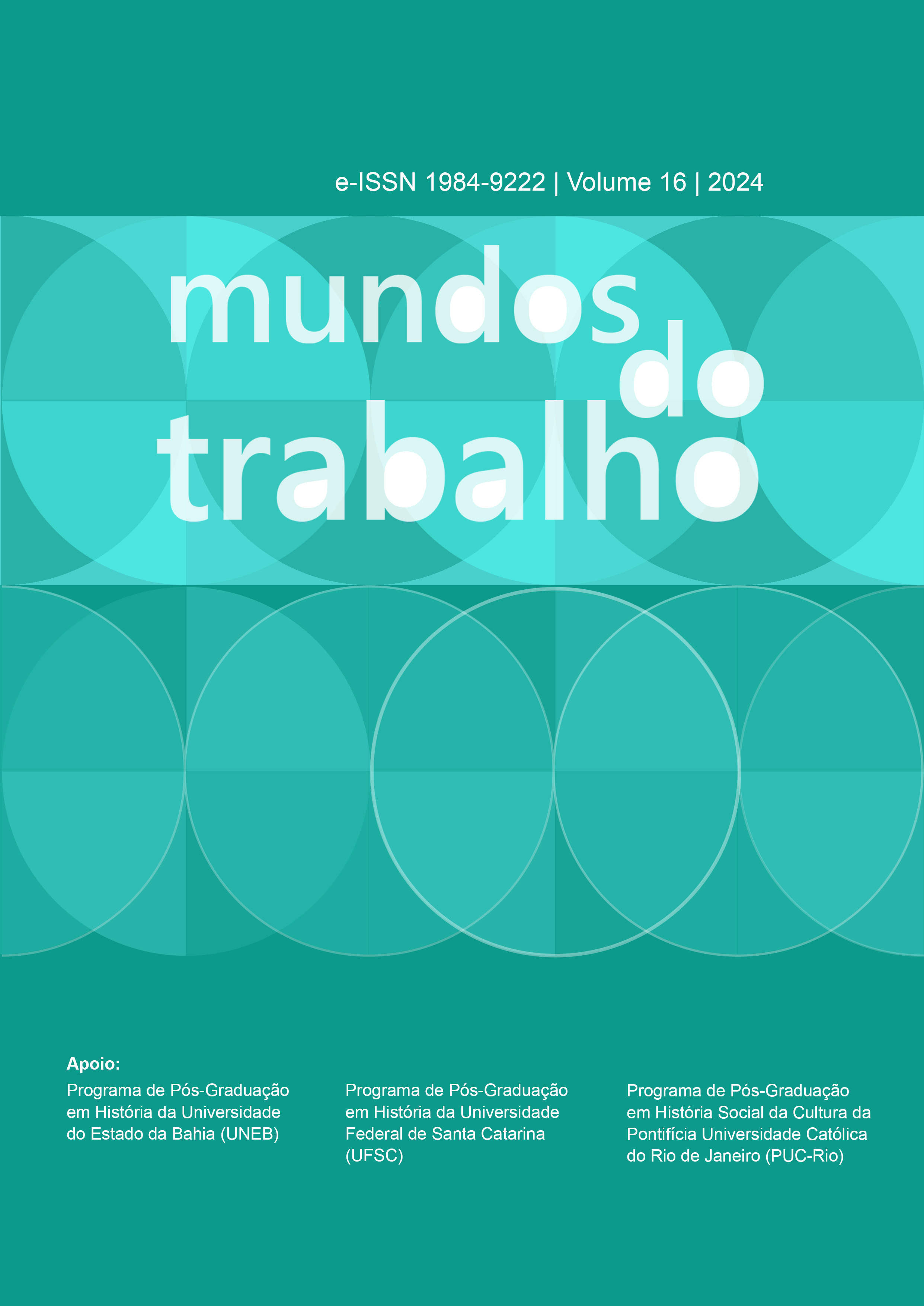Judíos rojos en Buenos Aires: comunismo en los mundos del trabajo idish hablante, 1917-1930
DOI:
https://doi.org/10.5007/1984-9222.2024.e103419Palavras-chave:
trabajadores judíos, mundos del trabajo, idish, culturas políticas de izquierda, Partido ComunistaResumo
Desde comienzos del siglo XX, la inmigración masiva de trabajadores judíos y familias de Europa central y oriental hacia Argentina generó las bases para que se consolidara un agrupamiento étnico que, en pocos años, se convirtió en la comunidad judía más relevante de América Latina, en un contexto de urbanización creciente y modernización capitalista. Al igual que en otras metrópolis contemporáneas, la población trabajadora de habla idish en Buenos Aires creó sus propias instituciones, redes y esferas de sociabilidad, generando rasgos propios y distintivos. No obstante, y de forma análoga al resto de la clase obrera, las culturas políticas de izquierda también desempeñaron un rol central en las formas de organización y de lucha del naciente proletariado judío. El artículo aborda la experiencia del comunismo y la formación de la sección judía (idishe Sektzie) a partir de la prensa política y gremial, bibliografía secundaria y, en particular, del periódico partidario en idish, Royter Shtern, una fuente que ha sido escasamente trabajada por la historiografía aunque insoslayable a la hora de cotejar experiencias sociales de naturaleza transnacional, inmersas de lleno en las contradicciones, tensiones y rupturas del período, tanto en el plano nacional como mundial.
Referências
ANSALDO, Paula. Broyt mit teater. Historia del teatro judío en Argentina. Buenos Aires: Eudeba, 2024.
BAILY, Samuel L. Immigrants in the lands of promise: Italians in Buenos Aires and New York City, 1870-1914, Nueva York: Cornell University Press, 1999.
BILSKY, Edgardo; TRAJTENBERG, Gabriel; WEINSTEIN, Ana Epelbaum. El movimiento obrero judío en la Argentina. Buenos Aires: AMIA, 1987.
BILSKY, Edgardo. Ethnicité et classe ouvrière: les travailleurs juifs à Buenos Aires (1900-1930). Le mouvement social, p. 39–56, 1992.
BRODSKY, Adriana M. Sephardi, Jewish, Argentine: Community and National Identity. Indiana: Indiana University Press, 2016.
BROUÉ, Pierre. Histoire de l’Internationale Communiste, 1919-1943. Paris: Fayard, 1997.
CAMARERO, Hernán. A la conquista de la clase obrera. Los comunistas y el mundo del trabajo en la Argentina, 1920-1935. Buenos Aires: Siglo XXI, 2007.
CAMARERO, Hernán. Antiguas controversias, nuevos enfoques: clase obrera, sindicalismo y comunismo en la Argentina durante la primera mitad del siglo XX: Un estado de la cuestión. Polhis, n. 11, p. 129–146, 2013.
CAMARERO, Hernán. La cultura política comunista en la clase obrera argentina de entreguerras: prácticas, repertorios de organización y subjetividad militante. Anuario del Instituto de Historia Argentina, v. 16, n. 2, 2016.
CAMARERO, Hernán. Tiempos rojos. El impacto de la Revolución rusa en la Argentina. Buenos Aires: Sudamericana, 2017.
CARR, Edward. El ocaso de la Comintern, 1930-1935. Madrid: Alianza, 1986.
CERUSO, Diego. La izquierda en la fábrica: la militancia obrera industrial en el lugar de trabajo, 1916-1943. Buenos Aires: Ediciones CEHTI - Imago Mundi, 2015.
CORBIÈRE, Emilio J. Orígenes del comunismo argentino (El Partido Socialista Internacional), Buenos Aires: Centro Editor de América Latina, 1984.
DEUTSCH, Sandra McGee. Crossing Borders, Claiming a Nation: A History of Argentine Jewish Women, 1880–1955. North Carolina: Duke University Press, 2010.
DEVOTO, Fernando J. Historia de la inmigración en la Argentina. Buenos Aires: Sudamericana, 2003.
ELKIN, Judith L. The Jews of Latin America. Boulder-London: Lynne Rienner Publishers, 2014.
GERCHUNOFF, Pablo. El eslabón perdido. La economía política de los gobiernos radicales, 1916-1930. Buenos Aires: Edhasa, 2016.
GREEN, Nancy L. The Pletzl of Paris: Jewish Immigrant Workers in the “Belle Epoque”. New York: Holmes & Meier, 1986.
GREEN, Nancy L. Ready-to-wear and ready-to-work: A century of industry and immigrants in Paris and New York. North Carolina: Duke University Press, 1997.
HÁJEK, Milos. Historia de la Tercera Internacional. La política de frente único (1921-1932). Barcelona: Crítica, 1984.
ITZIGSOHN, Sara et al. Integración y marginalidad. Historias de vidas de inmigrantes judíos en la Argentina. Buenos Aires: Editorial Pardés, 1985.
KALCZEWIAK, Mariusz. Polacos in Argentina: Polish Jews, Interwar Migration, and the Emergence of Transatlantic Jewish Culture. Tuscaloosa: University Alabama Press, 2019.
KOPPMANN, Walter L. Masculinidades y subjetivización política en el movimiento obrero argentino. European Review of Latin American and Caribbean Studies/Revista Europea de Estudios Latinoamericanos y del Caribe, Ámsterdam, núm. 111, p. 85-106, 2021.
KOPPMANN, Walter L. La madera de la clase obrera argentina. Izquierdas, etnicidad y género en una industria de Buenos Aires (1889-1930). Buenos Aires: Imago Mundi - Ediciones CEHTI, 2022.
KOPPMANN, Walter L. Aproximaciones para un análisis sobre la clase trabajadora judía de Buenos Aires en las primeras décadas del siglo XX, 1905-1930. Périplos: Revista de Estudos sobre Migrações, v. 6, n. 1, 2022.
LESSER, Jeff; REIN, Raanan. Introduction. In: LESSER; REIN, op. cit., p. 10.
LOBATO, Mirta Zaida. La vida en las fábricas. Trabajo, protesta y política en una comunidad obrera, Berisso (1904-1970). Buenos Aires: Prometeo/Entrepasados, 2001.
MICHELS, Tony. A fire in their hearts: Yiddish socialists in New York. Massachusetts: Harvard University Press, 2009.
MIRELMAN, Victor A. Jewish Buenos Aires, 1890-1930: In search of an identity. Michigan: Wayne State University Press, 1990.
MOYA, José. What’s in a Stereotype? The Case of Jewish Anarchists in Argentina. In: LESSER, Jeff; REIN, Raanan (eds.). Rethinking Jewish-Latin Americans. New Mexico: University of New Mexico Press, 2008.
PELED, Yoav; SHAFIR, Gershon. Split labor market and the state: the effect of modernization on Jewish industrial workers in Tsarist Russia. American Journal of Sociology, v. 92, n. 6, p. 1435–1460, 1987.
PERROT, Michelle. Les femmes ou les silences de l’histoire. Paris: Flammarion, 1998.
PONS, Silvio. The Global Revolution. A History of International Communism, 1917-1991. Oxford: Oxford University Press, 2014.
ROCCHI, Fernando. Chimneys in the Desert: Industrialization in Argentina during the Export Boom Years, 1870-1930. California: Stanford University Press, 2005
SIGWALD CARIOLI, Susana. El proletariado ruso judío. Desde la semana roja al centenario. Carlos Casares: Editorial del Archivo, 1991.
SOFER, Eugene F. From Pale to Pampa: A Social History of the Jews of Buenos Aires. New York: Holmes & Meier, 1982.
STUDER, Brigitte. The Transnational World of the Cominternians. Londres y Nueva York: Palgrave Macmillan, 2015.
WALD, Pinie. In gang fun tsaytn geshikhte fun sotsyalizm in Argentine: Yidn in der algemayner Argentiner sotsyalistisher arbeter-bavegung. [Al paso del tiempo: historia del socialismo en Argentina. Los judíos en el movimiento obrero argentino]. Buenos Aires: s/i, 1955.
WOLFF, Frank. Yiddish Revolutionaries in Migration: The Transnational History of the Jewish Labour Bund. Leiden - Boston: Brill, 2021.
YARFITZ, Mir. Impure migration: Jews and sex work in Golden Age Argentina. New Jersey: Rutgers University Press, 2019.
Downloads
Publicado
Como Citar
Edição
Seção
Licença
Os autores cedem à Revista Mundos do Trabalho os direitos exclusivos de primeira publicação, com o trabalho simultaneamente licenciado sob a Licença Creative Commons Attribution (CC BY) 4.0 International. Esta licença permite que terceiros remixem, adaptem e criem a partir do trabalho publicado, atribuindo o devido crédito de autoria e publicação inicial neste periódico. Os autores têm autorização para assumir contratos adicionais separadamente, para distribuição não exclusiva da versão do trabalho publicada neste periódico (ex.: publicar em repositório institucional, em site pessoal, publicar uma tradução, ou como capítulo de livro), com reconhecimento de autoria e publicação inicial neste periódico.









